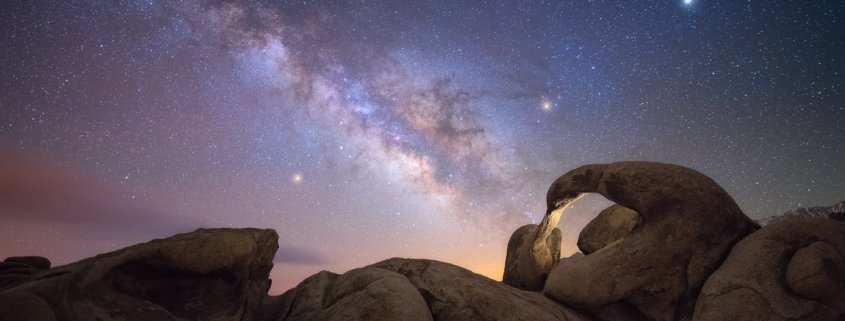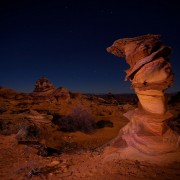Night Photography Tips for Photo Stacking
Night photography presents exciting opportunities for a landscape photographer to capture spectacular photos in the cloudless skies. With the technology advances in digital cameras over the last decade, night photography has grown rapidly in popularity. Today, landscape photographers can capture the night sky, the Milky Way, and northern lights with relatively inexpensive photography equipment.
Even if you have a fast wide angle lens with maximum aperture of f2.8 or higher, you are likely to use a high ISO setting on your camera to capture night photos. This introduces noise in your night photos. Pro photographers often rely on photo stacking technique and post processing to reduce the noise introduced by high ISO settings. Photo stacking workflow for night photography requires a number of different steps. Here are a few important lessons to successfully use photo stacking technique for night photography to produce a cleaner, brighter, and better photo of the Milky Way and the stars.

Sky: ISO 10,000, ƒ/2.8, 14mm, 15 seconds~15 frames stacked in Starry landscape Stacker, Foreground: ISO 10,000, ƒ/2.8, 14mm, 30 seconds
Why Photo Stacking for Night Photography?
The technique covered in this article is called photo stacking, not for focus or perspective, but for noise. Digital noise is generated by using a high ISO setting on DSLR and mirrorless cameras to capture the low light after dark. This increased noise due to high ISO setting is random so, put simply, this technique adds up a bunch of noisy night photos and averages them out to create a much cleaner photo.

On the left: One single exposure at ISO10000, ƒ/2.8, 15 seconds – On the right: 15 frames stacked in Starry landscape Stacker. |
The main reason you may want to try this is if you’re creating large fine art prints because noisy photos do not print well. Sometimes night photos usually print 1-1/2 f-stops to 2 f-stops darker than they appear on your LCD or your monitor. To adjust for this, you must adjust your camera exposure by selecting an even higher ISO setting which increases the noise even more.
Photo stacking for night photography will dramatically reduce the noise if you’re willing to put in a little extra work. I promise… it’ll be worth it! Before we start, the following are some things you’ll need…
- Intervalometer, or cable release
- Sturdy camera tripod
- DSLR or mirrorless camera
- A small LED panel or lantern if you want to add artificial light to part of your landscape
Fieldwork for Photo Stacking
The photo stacking technique for night photography must start in the field. Take between 10-15 consecutive frames with camera exposure settings for night photos you are trying to capture. For example, aperture of f/2.8, shutter speed of 15-20 seconds with ISO setting 10,000 (I know it seems high but this ISO setting allows you to lower your shutter speed for sharper stars). The goal is to use a low shutter speed and get the sharpest stars possible… with consecutive camera exposures with no gaps in between. Otherwise, photo stacking is more difficult when trying to align all of the frames (remember the earth is always rotating). It is prudent to make sure that any in-camera high ISO noise reduction or long exposure noise reduction is turned off. While you’re at it, make sure image stabilization on your camera lens is also off. You don’t want the camera lens trying to steady itself while on a tripod or it can actually have an inverse effect.
If you’re using any artificial lighting to light up the part of your landscape, play with that to avoid over-exposing or causing hot spots on the landscape of your night photo. An alternative is to take a second set of camera exposures at a longer shutter speed specifically for the artificially lit landscape and blend it in.
Once your exposure setting is locked in you will need to set your camera’s focus. Depending on how far you are from anything in the foreground, you can usually lock your camera’s focus at infinity. I usually use a bright star in live view, zoomed in 10x or more, and adjust the focus manually (using the focus ring on my camera lens) to make sure that all the stars are as round as possible.
Once you’ve done all of this… selected your night photography composition, locked your focus and set your camera exposure, and locked your camera down solid… you’re ready to take photos. Using a remote release takes between 10-15 frames (or more for better results) but I suggest starting here. Post post-process difficulty will increase with the number of frames your computer has to use to create a final night photo.
Post Processing for Photo Stacking
Basic Post Processing
When you’re back home in your digital darkroom, import your photos to your computer. Make your basic adjustments using your favorite RAW converter for the Milky Way and artificially lit landscape as needed. If you’re in Adobe Lightroom, make sure you turn sharpening off, but leaving color noise reduction on. This makes the finished stacked image look better. Once you’ve done all this, export the files as Tiffs, with no re-sizing or sharpening, to a location on your computer. Make sure you make a note of this location because you’ll need these photos in the next step.
Photo Stacking
Post processing for effective stacking for night photography doesn’t require a third party software but it really helps when trying to align, stretch, skew, and rotate frames to account for wide angle distortion and earths rotation.
If you’re on a Mac, I highly suggest Starry Landscape Stacker. It can be purchased in the App store. I have been using this software faithfully for more than three years and have created hundreds of print worthy images like the one below. For you PC users, you have a few choices to perform photo stacking for your night photos but the most convenient (and free) is “Sequator“.
In any case, take the time to thoroughly and precisely mask the sky from the foreground for night photography as outlined in the tutorials. Your finished product will be all the better for it. This technique takes a little practice and you may find you’re happy with a single frame from the set and don’t want to go through stacking. That’s ok! Its all about what you want out of your photos. Being out there under the stars is special no matter what.
Here are a few night photos (below) created using the photo stacking workflow. For both these night photos I used different camera exposure for the sky and the foreground. I then stacked multiple images together using Starry Landscape Stacker and Photoshop.
As you can see that with a little knowledge and some practice, capturing stellar night images will be more than just a shot in the dark. You may find you’re happy with a single night photography frame from the set and don’t want to go through the process of photo stacking. That’s ok! It’s all about what you want out of your photos. Being out there under the stars is special no matter what.














